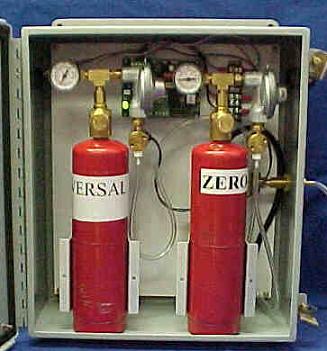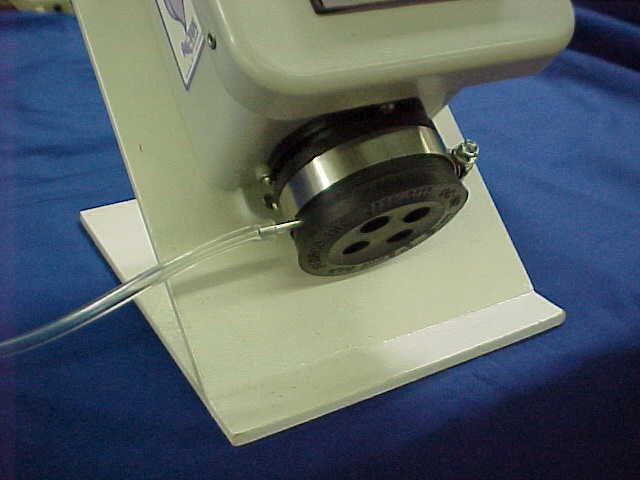
UnitKal-DX™ - Automatic calibration for gas sensors in mining.
Monthly calibration of gas sensors is mandated by MSHA regulations. However,
the implementation of this monthly routine can consume a great deal of
time and resources. Calibration events are usually scheduled for a specific
date, however, there may be delays encountered, causing missed calibration
dates and risking safety violations.
UnitKal-DX™ is a small version of Rel-Tek's AutoKal-DX™ system. AutoCal-DX
was developed to calibrate up to 32 sensors at a time, ideal for above
ground applications involving a large numbers of sensors concentrated
in a particular locale. UnitKal-DX™, however, was developed as an economical
utility for mining, where sensors are scattered along a conveyor belt,
and where only one or two sensors are within reasonable cal-gas delivery
range.
The UnitKal-DX™ panel and the automatic calibration process are controlled
by the Millennia-DX® computer that is already on site monitoring the
mine for CO, CH4 , O2 , smoke, air velocity, etc.; activating alarms and
controls; logging data; displaying status and printing reports.
The UnitKal-DX™ box contains two tanks of calibration gas, one having a
up-scale (span) mixture and one having pure (zero) air. Two solenoid valves
are controlled by the computer through a DX2202 I/O card which successively
admits span and zero gas, precisely timed for a preset duration through
a ¼ inch diameter tube connected to the sensor. Sufficient time)
is allowed for the sensor outputs to stabilize. The computer then re-scales
the sensor setup information stored in the computer memory to capture
the new parameters, using a very precise 12-bit (1/4096 or +/-.024%) resolution.
If the sensor fails to provide sufficient range, the computer reports
the sensor as faulty and records this information for management attention.
The automatic calibration process is over in about four minutes, faster
than with manual calibration. The process will be automatically repeated
on a monthly basis, yet without the bother and cost of scheduling and
deploying manpower again. Sufficient calibration gas is included in the
initial charge to handle about 20 calibration events, more than enough
to cover a year's time. At the end of the year, just replace the gas tanks,
and you're good for another year. Calibration cycles are normally scheduled
monthly, although the duration can be set for semi monthly, weekly, or
even daily, if needed. A click on "calibrate now utility is also
available to check a sensor out of schedule, as following sensor service
or replacement.
A gas leak is always possible, although not likely. But, in the event
of insufficient cal gas reaching the sensor to complete a calibration
cycle, the sensor will fail to span properly. The computer recognizes
the problem and aborts the automatic calibration cycle. A "failed
calibration" entry is made in the calibration file, alerting management
of the need for maintenance.
 A
significant cost benefit of UnitKal-DX™ that may not be obvious at first
glance is the life extension of the sensor. Sensing elements tend to loose
sensitivity as they age. When the sensor signal drifts beyond normal zero
and span adjustment, it is normally replaced, usually at a cost about
half the price of the sensor. UnitKal-DX™, however, disregards the normal
adjustments at the sensor and relies only on the digitized range. The
computer uses 12-bits (4096 digitizing steps) to represent the extreme
high/low boundaries of the range. On automatic calibration, the computer
assigns a sub-range to whatever movement is still available on an aging
sensor. As long as this sub-range contains at least 256 bits, the sensor
is deemed OK, and life continues. This sub-range can shrink by a factor
of 16 (4096/256) before the computer finally retires the sensor and calls
for service. CO sensors as old as 8-10 years can still have sufficient
response left to perform adequately, a far cry from the usual 1-2 year
replacement cycle for most sensor suppliers. Similarly for methane and
oxygen sensors, an aging cell need not signal end of life when UnitKal-DX™
is in use. Methane sensors with a lifespan of 10-20 years is possible,
while oxygen sensors, usually with 1-year life at best, can continue in
operation for extra years. A
significant cost benefit of UnitKal-DX™ that may not be obvious at first
glance is the life extension of the sensor. Sensing elements tend to loose
sensitivity as they age. When the sensor signal drifts beyond normal zero
and span adjustment, it is normally replaced, usually at a cost about
half the price of the sensor. UnitKal-DX™, however, disregards the normal
adjustments at the sensor and relies only on the digitized range. The
computer uses 12-bits (4096 digitizing steps) to represent the extreme
high/low boundaries of the range. On automatic calibration, the computer
assigns a sub-range to whatever movement is still available on an aging
sensor. As long as this sub-range contains at least 256 bits, the sensor
is deemed OK, and life continues. This sub-range can shrink by a factor
of 16 (4096/256) before the computer finally retires the sensor and calls
for service. CO sensors as old as 8-10 years can still have sufficient
response left to perform adequately, a far cry from the usual 1-2 year
replacement cycle for most sensor suppliers. Similarly for methane and
oxygen sensors, an aging cell need not signal end of life when UnitKal-DX™
is in use. Methane sensors with a lifespan of 10-20 years is possible,
while oxygen sensors, usually with 1-year life at best, can continue in
operation for extra years.
The economics of automatic calibration depend on the cost of labor, as
well as on other factors such as availability of trained personnel, the
likelihood of missing calibrations, the dependability of technical personnel,
the availability of supplies (cal gas), instruments (portable meters and
tools) and the like.
But safety aspects are also to be considered. UnitKal-DX™ can eliminate
exposure of calibration personnel to hazardous conditions, as when visiting
sensors in gob areas, in silos and over moving belts and machinery.
UnitKal-DX™ isn't for every mining operation -- only those which utilize
a Rel-Tek monitoring system or which are planning to install a Rel-Tek
monitoring system. Although UnitKal-DX™ essentially doubles the initial
cost of the sensor -- considering the ongoing savings in labor and the
sensor life enhancement mentioned above -- the economics can be very favorable.
For more information, contact the factory or your sales representative.
|